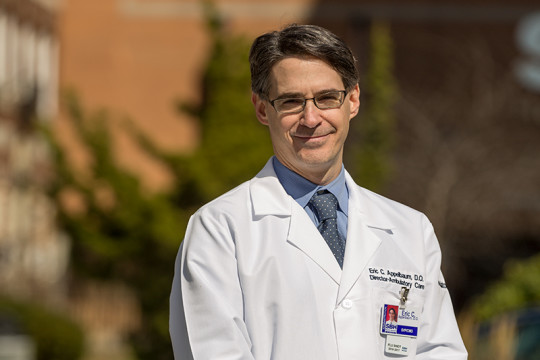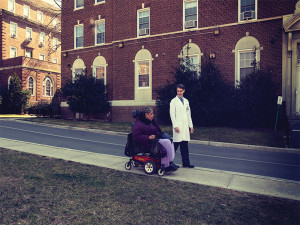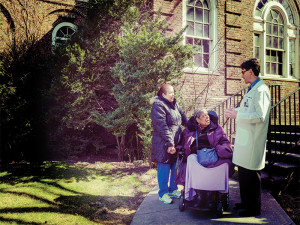
Dr. Eric Appelbaum is the new Chief Medical Officer at SBH, replacing Dr. David Perlstein, who is now President/CEO. Dr. Appelbaum, who was previously in charge of the hospital’s emergency and ambulatory care departments, has assembled a new leadership team comprised of Dr. Manisha Kulshreshtha and Dr. Daniel Lombardi, associate medical directors; and Dr. Robert Karpinos, medical director of Perioperative Services.
SBH Physician Magazine recently spoke with Dr. Appelbaum to get his take on SBH and its future. Below is an excerpt from this interview.
 Q. You often talk about the importance of the doctor and patient relationship. Why is this so important to you personally and why does it make a difference in the kind of care the hospital provides to the community?
Q. You often talk about the importance of the doctor and patient relationship. Why is this so important to you personally and why does it make a difference in the kind of care the hospital provides to the community?
A. To me personally, having practiced here as a resident and then an attending physician, and now in a leadership position, it’s all about maintaining patient relationships. That’s the reason I became a doctor in the first place – to develop these relationships and to see people through their illnesses and through their health. I’m very fortunate to have patients who have been with me for 15, 20 years.
My residents are surprised when I am with a patient whom I’ve known for a long time and can recite the names of the patient’s children and the like. I want my residents to develop that kind of relationship. It makes the experience that much richer for both the doctor and the patients.
And I take my part of the relationship very seriously – I will advocate for my patients like they’re my family, because in my mind they are. I’m fortunate to have had the chance to form these close ties.
But I’m not unique. You could fill up a room with SBH docs who have known patients for years and years and years. That’s the model that I learned as a first-year resident and continue to follow. The fact that our docs have decades-long relationships with their patients is a testament to their dedication. That means that the doc has earned that patient’s faith and trust. I think that’s pretty amazing. One of our pediatricians has treated the same family for more than 30 years — caring for parents, children and grandchildren. That’s one of the great things about SBH.
Q. This is your 20th anniversary at SBH. Are you more enthusiastic about the future of the hospital today than when you first came here in 1997 as a resident?
A. Yes, I am, mostly because the healthcare industry has shifted its focus to wellness and because of the power of technology. For example, the use of electronic medical records has enabled us to provide better care. Many of us were worried back when they were first introduced that we’d have a tough adjustment, but it’s really been very helpful. So is the fact that the reimbursement landscape has changed so that we’re rewarded for keeping patients out of the hospital. That changes the dynamic, and allows us to work as a partner with the patient to develop healthy habits. This, to me, is really rewarding. Having a family and watching them grow has really turned my attention to making sensible food choices and a healthy lifestyle.
I really love the fact that we’re going to get to focus on wellness. It’s been a personal journey for me to really focus on how healthy or unhealthy I was being, and now that I can bring my colleagues and my patients along on that journey, that’s exciting.
Q. What do you see as the hospital’s main strengths?
A. In addition to that emphasis on patient relationships that we just discussed, I think another strength is our involvement in the community. We feel a tremendous sense of loyalty to this community and want to see it get healthy. Our Third Avenue Project, which will bring affordable housing and a medical village right across the street, has made so many of our staff proud of SBH.
 Q. What is your vision as Chief Medical Officer?
Q. What is your vision as Chief Medical Officer?
A. My vision aligns with the hospital’s vision: to be the premier hospital destination in the Bronx, and to provide the right service at the right time at the right cost in a patient-centered manner for our community. Perhaps the only difference from my predecessors — probably because we weren’t able to fully execute it before — is the focus around wellness and keeping people healthy. We have to change what we say from “I’ll be here when you get sick” to “Here’s how I’m going to prevent you from getting sick.” The conversations are shifting to nutrition, exercise, weight management, about preventive stuff. Sure, if I do the basic routine screenings that are done in an annual checkup I might not be able to prevent certain things from happening, but if we spend that 45 minutes talking strictly about diet, maybe I can keep you well, and then hopefully extend that to your family.
Q. Are there any initiatives or services on the drawing board we can discuss?
A. The Third Avenue Project is our number one priority, and it’s slated to open early in 2019. It has the potential to transform how we do things here at SBH. There will be a gym there so we can partner with our patients to help get them moving, and there’ll be a teaching kitchen to show people how to cook in a culturally accepted but healthy way. That’s a big shift in how we’re treating our patients. Our ambulatory health centers have to be seen as destinations for wellness, not for treating diseases. My goal is to put a sign on the door that says, “Come here to get and stay well.”
We’ve already been doing some of this, like with our diabetic educators and our smoking cessation class. I’ve already seen it start to creep into the mindset of the physicians as they talk to their patients. We’ve been partnering with the community through DSRIP and have relationships with our PPS partners like Air Bronx, who take care of asthmatics in a whole different way. We need to become partners with the government and the leadership of the city, the state, and the nation in order to figure out ways to encourage this approach throughout our healthcare system.
Right now, we’re also introducing new services. We have three new vascular surgeons who are doing endovascular procedures that haven’t been done here before. We’re doing some new neurosurgical procedures in the world of pituitary tumors. We are continuing to expand our electrophysiology services. These are all very exciting for our patients.
Q. What do you see as some of the challenges?
A. I don’t think SBH is any different from other hospitals in New York City in that recruitment is a challenge. It’s not because being in the Bronx is a problem – it’s that today it’s so much easier for people to move longer distances because the technology allows them to stay connected to their friends and families. It’s no longer a big deal for someone who’s from this area to pick up and move to Texas, for example. People can go on social media and talk to and literally see their families on the screen every night. They might go for nicer weather, or they might go for more compensation, so we need to stay competitive. The other challenge is reimbursement. Costs go up, and reimbursement doesn’t, and we have to make sure we control how we do things while remaining true to our vision, our mission and our core values.
Q. Yet, you do seem to attract some incredibly talented and well-trained physicians. How do you accomplish that?
A. First, we’ve been fortunate to attract people who want to work in underserved areas. That’s noble, and we love that. But the second thing is when applicants meet the physicians, staff, and department that they would work in, they get a real sense of family, of camaraderie. I mean, it’s not always all about money. As my father always told me, you’ve got to wake up and want to go to work. Practicing medicine at Hospital A vs practicing medicine at Hospital B can be very different. There can be a completely different culture, a different climate, and I think we have a good one, and I think it comes across pretty quickly. You could literally interview here at SBH with four or five people, and I can safely say, “Do you realize you’ve just spoken to about 130 years of experience at this hospital in about an hour?” That’s pretty unique. Our passion for what we do comes across right away.
Q. What about the initiatives like Just Culture and the Triple Aim Plus One?
A. One of the initiatives Dr. Lombardi has begun implementing at SBH is Just Culture. Just Culture is a way of looking at accountability and how to strengthen systems to reduce the likelihood of error. Essentially, it’s a simple algorithm that looks, not first to assign blame but to determine if our procedures are wrong and to be able to intervene appropriately. So if we set someone up to fail by a bad process, we need to vet that process.
In a Just Culture our first question when an error occurs anywhere in the hospital is whether we’ve set the responsible staff member up to fail, through unclear policies, a computer error, or some other reason.
The other big initiative is the Triple Aim Plus One, which was developed by the Institute of Healthcare Improvement many years ago. It’s a set of three goals — to be patient-centered, to provide care at the right cost, and to have good outcomes. The Plus One aspect means providing some degree of joy and satisfaction to our employees. Those three pillars are the foundation for how we will provide medical care and comfort going forward. The real challenge of the Triple Aim is satisfying all three pillars simultaneously. For example, I can improve patient access by loading up an office with too many patients. Well, the access is great, but is that patient-centered? And, maybe I’ve made it low cost because I’m working efficiently, but it’s still not really patient-centered. So we have to look at all three tenets, and that’s an ongoing challenge. We’re thinking about it every day, and it drives how we do everything here.
Q. Where do we stand with the Montefiore merger?
A. As you look across New York State, New York City specifically, you see a lot of big systems merging. It’s driven by economics, but often these collaborations result in better care for patients. Montefiore is a natural partner here for SBH. We already have a huge list of clinical collaborations with them, so it only makes sense to explore a partnership. And that’s how we view it – as a partnership, not a hostile takeover. If we’re really committed to continuing our mission to serve this community, the right thing to do is to make sure we can continue to serve. So if that means we merge to better take care of patients, then we have to do what’s right for our community.
 GIVING
GIVING (718) 960-9000
(718) 960-9000